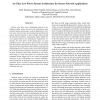Free Online Productivity Tools
i2Speak
i2Symbol
i2OCR
iTex2Img
iWeb2Print
iWeb2Shot
i2Type
iPdf2Split
iPdf2Merge
i2Bopomofo
i2Arabic
i2Style
i2Image
i2PDF
iLatex2Rtf
Sci2ools
111
click to vote
ISCA
2005
IEEE
2005
IEEE
An Ultra Low Power System Architecture for Sensor Network Applications
Recent years have seen a burgeoning interest in embedded wireless sensor networks with applications ranging from habitat monitoring to medical applications. Wireless sensor networks have several important attributes that require special attention to device design. These include the need for inexpensive, long-lasting, highly reliable devices coupled with very low performance requirements. Ultimately, the “holy grail” of this design space is a truly untethered device that operates off of energy scavenged from the ambient environment. In this paper, we describe an application-driven approach to the architectural design and implementation of a wireless sensor device that recognizes the event-driven nature of many sensor-network workloads. We have developed a full-system simulator for our sensor node design to verify and explore our architecture. Our simulation results suggest one to two orders of magnitude reduction in power dissipation over existing commoditybased systems for an impo...
Related Content
| Added | 25 Jun 2010 |
| Updated | 25 Jun 2010 |
| Type | Conference |
| Year | 2005 |
| Where | ISCA |
| Authors | Mark Hempstead, Nikhil Tripathi, Patrick Mauro, Gu-Yeon Wei, David Brooks |
Comments (0)

